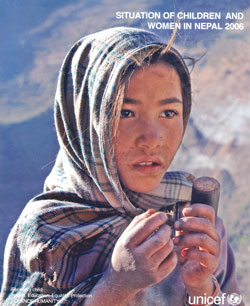 |
For a country wracked by conflict, Nepal has shown surprising progress in child survival and literacy in the past decade. But there is still a long way to go.
That is the message of UNICEF's Situation of Children and Women in Nepal survey that looks at key indicators and projects them till 2015, the year by which key development targets worldwide are supposed to be met.
The numbers look daunting:l Half of Nepal's population of 27 million are children below 18l Nearly 550 mothers out of every 100,000 die at child-birth, one of the highest rates in the worldl Only 10 percent of deliveries are done in hospital or health postl One in every 25 babies born die in the first month of lifel One in every 15 will not live to be one year oldl One in every five children of school-going age is not in schooll Only four out of 10 children complete primary school With statistics like that, we should have a government that is very worried, but it is so preoccupied with the politics of elections there is very little effort to improve healthcare. That is why experts are worried about reversals even in the modest gains we have seen in the past 10 years.
More worryingly, there has been a huge jump in security-related expenditure (a jump of 15 percent per year since 2003) and much slower growth in health, education and sanitation (11 percent) in the same period.
Most of the world's developing countries, including Nepal have committed themselves to meeting the UN's eight Millennium Development Goals (MDGs) to halve poverty, reduce hunger and improve maternal and child health by 2015. Last month, Nepal with Cambodia and several African countries became the "first wave" nations to sign an agreement in London to meet the targets.
The initiative was launched by British prime minister Gordon Brown and will commit resources to improve healthcare and retain doctors and nurses in their own countries.
If current improvements can be sustained, Nepal is set to meet most MDG targets. Poverty is likely to be halved by 2015, and hunger also reduced. Maternal mortality, serious as it is, is also on course to be brought down to 100 per 100,000 births in eight years\' time. Similarly child mortality is expected to reach 40 per 1,000 live births (fromthe present 70) by 2015.
However, one MDG target that Nepal will likely fail to reach is to ensure universal primary education, says the UNICEF survey. Also, even though targets may be reached taking national averages, the rates for vulnerable groups like janjatis and dalits are improving more slowly.
Gender disparities in child survival and education will also remain. For example most of the dropouts from primary schools are girls. The median age for marriage is still only 16.6, meaning child marriages are still prevalent.
Kunda Dixit


